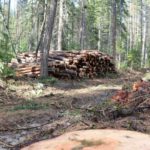Collaborate: A New Era
Posted: October 30, 2017Source: The Forest Blog by Russ Vaagen
I read and hear people talking about how the environmentalists are to blame for all our forest health woes. I also hear about the same on the other side of the coin saying that over-harvesting and past logging is the reason our forests are in the shape they are in. Here’s my take:
 WHO CARES WHOSE FAULT ITIS!
WHO CARES WHOSE FAULT ITIS!
Besides making you feel better about your position, what good are you doing? We need change, not blame. The fact is there are members of the forest industry and conservation groups working tirelessly to collaboratively address the issues facing our forests.
Collaboration is Working
We need to further support efforts of collaborative groups. The great work needs to be shared so people understand that the days of the “Timber Wars” are over. Sure, I understand that some environmentalists still want the forest left off limits, public land, in particular. Let me tell you, that is the minority. There are also sawmill owners and timberland managers that want nothing to do with collaboration or talking with the “enemy.” Those people and organizations have become and are becoming the exception. It’s because of this we must focus on the good work of groups in the West. They have gone past the noise to a better way of solving our forest management issues.
On the Colville National Forest, we have over 3 dozen successfully collaborated projects. They are growing in size and agreement as we learn from each one. We are now focused on landscape-level impacts rather than smaller projects. We are trying and succeeding at restoring a higher percentage of the forest within each project area. The A to Z project is a national example of that success, but the truth is, it’s just another step in the process. We still aren’t seeing enough of that land being thinned and restored. There is no shortcut to all of this. We must do the work. Go to the meetings. Have the discussions. Create common ground and move the needle forward.
We All Benefit
When these projects are completed everyone wins. Our forests get the fuels reduced which saves them from catastrophic, stand replacement wildfire. This allows them to keep producing oxygen and creating healthy, beautiful forests for generations to come. Wildlife habitat is saved or enhanced. Recreational opportunities are restored instead of destroyed. Rural economic engines are fueled with the by-product of restoring or public forests which does more for the socio-economic fabric of these communities than most people will ever know. In the near future, we will be turning these forest restoration by-products into mass timber, specifically CLT, which will benefit urban communities with sustainable, eco-friendly buildings.
The fault of how we got the forest in this mess is irrelevant. The past doesn’t exist today. We can only take actions today that will influence a brighter future. Understanding history is one thing, making excuses and blaming others is a copout. Be part of the solution, not the ineffective noise.


 WHO CARES WHOSE FAULT ITIS!
WHO CARES WHOSE FAULT ITIS!